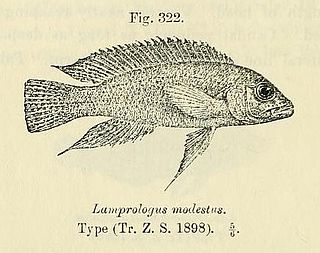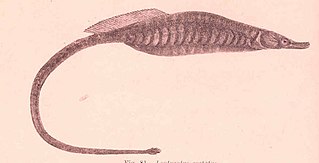
Mycteroperca microlepis, the gag, also known as gag grouper, velvet rockfish or charcoal belly, is a species of marine ray-finned fish, a grouper from the subfamily Epinephelinae which is part of the family Serranidae, which also includes the anthias and sea basses. It comes from warmer parts of the West Atlantic, including the Caribbean and Gulf of Mexico. It is a drab, mottled-gray fish lacking the distinguishing features of most other groupers. Its pattern of markings resemble the box-shaped spots of the black grouper. It lacks the streamer-points on the tail fin that scamp and yellowmouth grouper have and lacks yellow coloration around the mouth.

The Japanese angelfish or Japanese pygmy angelfish, is a species of marine ray-finned fish, a marine angelfish belonging to the family Pomacanthidae. It is found in the western Pacific Ocean.

Variabilichromis moorii has no common name and is a species of freshwater cichlid endemic to Lake Tanganyika in eastern Africa. It is a small ovate bodied fish named for an early collector of fish from the lake, John Edmund Sharrock Moore (1870-1947) who was a cytologist, zoologist and led an expedition to Lake Tanganyika and who discovered this species. Juveniles are usually yellow, and adults are dark brown to black in color. It reaches a total length (TL) of 10.3 centimetres (4.1 in). Currently it is the only member of its genus. V. moorii feeds on algae, zooplankton, and benthic invertebrates. It is also found in the aquarium trade.

Neolamprologus brevis is a species of cichlid endemic to Lake Tanganyika where it lives in snail shells, primarily of the genus Neothauma. It feeds is on plankton. This species can reach a length of 5.5 centimetres (2.2 in) TL. This species can also be found in the aquarium trade. The males are much larger than the females and can be identified even at a young age.

Neolamprologus multifasciatus is one of the small shell-dwelling cichlids endemic to Lake Tanganyika. The male reaches 5 cm (2 in) in length, and the female only 2.5 cm (1 in) in the aquarium. In the wild, they reach only 3 centimetres (1.2 in) in standard length of male and female reaches less than 2.2 centimetres (0.87 in) in standard length. This makes them one of the smallest cichlid species in the world. Its natural habitat is the Neothauma shell beds of Lake Tanganyika, where it forms huge colonies with thousands of individuals. Their unique behavior is associated with their affinity to shells. They burrow sand to move shells, take refuge in shells and also breed in them. They have pale white coloring with black vertical bars running the length of their bodies. The species is sexually monomorphic, meaning sexing individuals is extremely hard or impossible based on external appearance alone.

Lepidiolamprologus boulengeri is a species of cichlid endemic to Lake Tanganyika where it is known from the Tanzanian coast in the northern part of the lake. Pairs of this species live together in their territory and the female lives in snail shells in a pit that they have dug in the sand. This species can reach a length of 6.2 centimetres (2.4 in) TL. This species can also be found in the aquarium trade.

Neolamprologus modestus is a species of cichlid endemic to Lake Tanganyika where it lives on rocky substrates in the southern portion of the lake. It breeds in areas with sandy substrates. Generally eating small snails, it also specializes on eating the eggs of Lamprichthys tanganicanus, a species of killifish. Males of this species can reach a length of 12 centimetres (4.7 in) TL while the females only grow to 10 centimetres (3.9 in) TL. This species can also be found in the aquarium trade.

Neolamprologus mondabu is a species of cichlid endemic to Lake Tanganyika except for the southern portion where it is replaced by N. modestus. It prefers areas with rocky substrates, moving to areas with sandy substrates to breed. It feeds on the eggs of Lamprichthys tanganicanus. This species can reach a length of 10.7 centimetres (4.2 in) TL. This species can also be found in the aquarium trade.

Neolamprologus pulcher is a species of cichlid endemic to Lake Tanganyika where it prefers locations with plenty of sedimentation. The common names for N. pulcher include daffodil cichlid, fairy cichlid, princess of Zambia and lyretail cichlid. This species can reach a length of 10 centimetres (3.9 in) TL. It can also be found in the aquarium trade.

The two-spotted goby is a species of goby native to marine and brackish waters of the eastern Atlantic Ocean where it can be found from the Faeroes and Norway to the northwestern coast of Spain. It has also been recorded from Estonia though records from the Mediterranean Sea are uncertain. They are common on all coasts of the United Kingdom. This species can reach a length of 6 centimetres (2.4 in) TL.

Cephalopholis miniata, also known as the coral grouper, coral hind, coral rock cod, coral cod, coral trout, round-tailed trout or vermillion seabass is a species of marine ray-finned fish, a grouper from the subfamily Epinephelinae which is in the family Serranidae which also includes the anthias and sea basses. It is associated with coral reefs and occurs in the Indo-Pacific.

Cephalopholis panamensis, the Pacific graysby or Panama graysby, is a species of marine ray-finned fish, a grouper from the subfamily Epinephelinae which is in the family Serranidae which also includes the anthias and sea basses. It is found in the Eastern Pacific Ocean.
The spotted dragonet is a species of dragonet native to the eastern Atlantic Ocean and the Mediterranean Sea where it occurs at depths of from 45 to 650 metres. This species is important to local peoples engaged in subsistence fishing.

The seaweed blenny is a species of combtooth blenny found in coral reefs in the western Atlantic Ocean along the coasts of New York, Bermuda, the Bahamas, also in the Gulf of Mexico, south to southern Brazil. This species reaches a length of 8.5 centimetres (3.3 in) TL.

The deepbody pipefish is a species of pipefish endemic to Australia where it is only found along the southern coast. This species grows to a length of 12.9 centimetres (5.1 in) SL. This species is the only known member of the monotypic genus Kaupus which is named in honour of the ichthyologist Johann Jakob Kaup (1803-1873).

Genicanthus melanospilos, the spotbreast angelfish, blackspot angelfish or swallowtail angelfish, the family Pomacanthidae. It occurs in the Indo-West Pacific region.
The lipstick darter is a species of freshwater ray-finned fish, a darter from the subfamily Etheostomatinae, part of the family Percidae, which also contains the perches, ruffes and pikeperches. It is endemic to the eastern United States, where it occurs in the Tallapoosa River drainage above the Fall Line in Alabama and Georgia. It inhabits rocky riffles of creeks and small to medium rivers.
Gurgesiella atlantica, commonly known as the Atlantic pygmy skate, Atlantic finless skate, or simply the Atlantic skate, is a skate species in the family Gurgesiellidae. It lives in the western central and southwest Atlantic Ocean, from Nicaragua to Brazil. It grows to 49 centimetres (19 in) – 52 centimetres (20 in) long and is distinguished from other skates by its long, slender tail and absence of dorsal fins.
Torpedo mackayana, commonly known as the ringed torpedo, Western African torpedo, West African torpedo ray, McKay electric ray, or McKay's torpedo ray, is an electric ray species in the family Torpedinidae, which lives in shallow waters on the western coast of Africa. Characterized by rounded spiracles and white and brown spots, females grow to 35–50 centimetres (14–20 in) and males to 31.5–38.2 centimetres (12.4–15.0 in).
Hologymnosus longipes, the sidespot longface wrasse or the plain slender wrasse, is a species of marine ray-finned fish from the family Labridae, the wrasses. It occurs in the western Pacific Ocean.
















